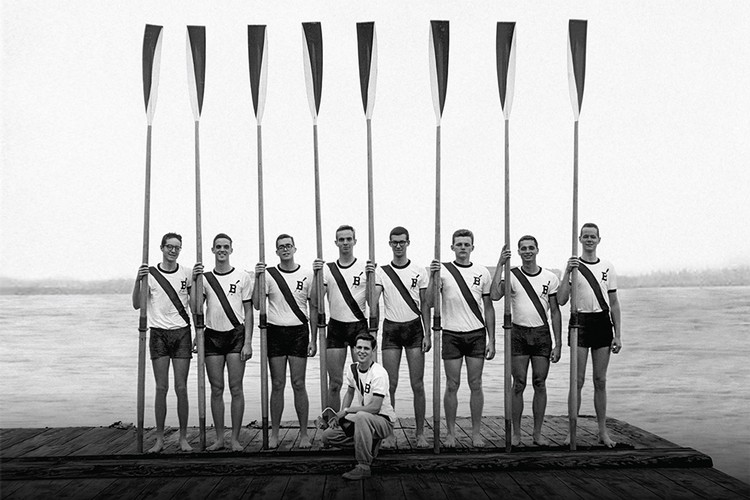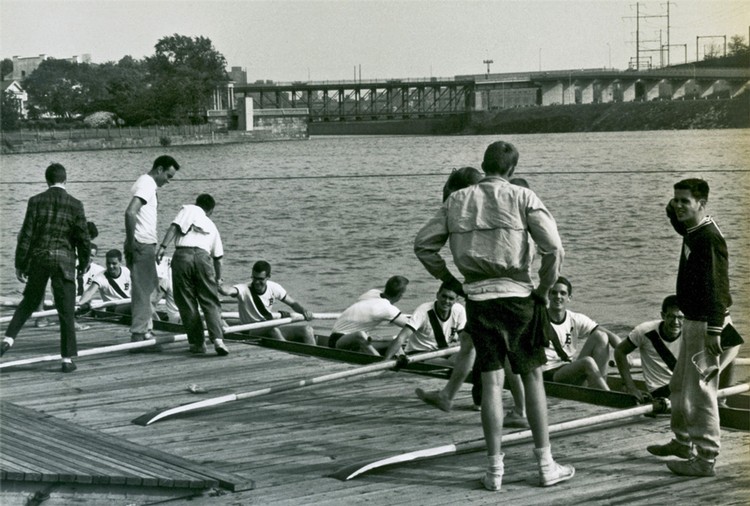
A second race in spring flood occurred on my favorite river. Something strange always happens when I go near the Connecticut. In a race near Northampton, Amherst College disappeared in a fog bank. This was their home course. What if they were familiar with a back-eddy we didn't know about?
But Mouse steered us to the finish line very well and when Amherst emerged from the fog the margin was curvature of the earth.
Reader, if you think I tell that story to humiliate poor Amherst you are mistaken. There is reason for the telling which will become apparent my senior year.
But my family had its own relationship to the Connecticut River. First, my older sister had her piano-destroying party at Hegamumpus/Higganum and then another at the same place for the Ledyard Canoe Club.
John Ledyard was a failed Dartmouth student and dreamer and world-renowned explorer who sailed on Captain Cooke's third voyage. Everything about him is legend, with facts not particularly important. Ledyard is where Harvard and Yale have their supernumerary boathouses, but why wasn't a town on the Connecticut named after the man?
Well, Ledyard was born November 1751 in Groton, Connecticut-- the argument for a township on the Thames (rhymes with frames). When Ledyard attended Dartmouth College it was but three years old. He left it for two months without permission, sort of like when Peter Amram drove his car into a Brown quadrangle or when Bill Stowe stole his Christmas Creche. John led a mid-winter camping expedition and finally quit Dartmouth altogether.
His worldwide schemes, one involving pelts, mostly failed. His business deals supposedly involved Thomas Jefferson, John Paul Jones, the Adams family and other prominent historical persons. He may have been the first American to set foot on the left coast and Hawaii. He possibly traveled more than Richard Halliburton or Marco Polo.
He was hiking across Siberia when Catherine the Great had him arrested and deported to Poland-- the similarity to Polo's name? In Egypt he drank sulphuric acid by mistake and died at the age of thirty-seven.
My favorite story about him however is that while in Hanover he wanted to see his grandfather two future states downriver in Hartford and built himself a canoe. He paddled when he had to but preferred to let the current carry him south and was lying on his back reading Ovid when he realized his boat was about to plunge down the forty-foot drop of Bellows Falls. In his panic he capsized and lost his supplies but made it to shore.
Each year the Ledyard Canoe Club of Dartmouth College paddles down the river. Usually they start at Hanover. One year they started at the fourth Connecticut Lake in Canada and did the full four hundred and ten miles-- usually though they start at Hanover part way down like Ledyard himself.
My sisters, one older and one younger, would always give them a concluding party. This happened both at Hegamumpus (now known as Higganum) and at Fenwick, Old Saybrook, when we moved the last eighteen miles closer to the Long Island Sound. Life Magazine did a spread on the Ledyard Canoe Club and my sisters.

The father of Mouse, horrified that his son was driving a swaying lancelike thing, gave the crew an old pickup truck with a heavy wooden superstructure, an improvement that continued to ominously sway.
Arriving to the north of Hanover we started to unpack the Stein and the Brown crew oars.
A member of the Dartmouth crew who had beaten us the year before asked, "How come your oars aren't painted?" No one replied. The secret answer was long practices that wore the paint off.
Salt water in the American northeast stayed open for more of the year. And the Connecticut, in spring flood, was just dispatching an assortment of ice floes. The one that hit my 4-oar during the actual race was exactly the same size as the one grounded by shore I used to practice my slap-shot from in Higganum/Hegamumpus.
I was home alone not attending school because of infectious mononucleosis. My target for the slap-shots was a card table set on edge up on land. My shoes were sliding around on the ice as the floe dislodged and drifted toward the shipping channeI.
I leapt for shore but didn't make it. The water felt warm and tingly. I splashed up on the bank. Result: pneumonia.
We jumped Dartmouth at the start then understroked and won by two lengths setting a speed record that will never be broken. And had a similar start in the Dad Vail to conclude our regular season.
Everything in Philadelphia conspired for us. As the top seed in the Dad Vail we were permitted to launch nearer to the starting line than the other crews-- maybe not entirely fair but we would take it.
"Are you ready," blared the referee's amplified voice. "Get ready. Row."
I remember hitting a partial stroke as hard as I could and then the full stroke that came after that as well and thinking, "Hey, this isn't so bad. Let's try that again." And so on. The way Whitey indoctrinated us was to hit the catch and go full out all the time no matter how far we were about to row.
In actuality no one does that. Twenty power strokes to start, five ordinary strokes to settle and God help you if you don't "settle" which is another word for relax. Fail to settle and you remain in panicky hell all the way down the course.
No, we didn't go as high as usual at the start-- about 40 strokes per minute and then a 33 or 34, slower than most of the other boats.
St. Joseph's College of Philadelphia was in second but way back. And I kept sending myself the simple message. "Another power stroke. Again."
The thing about a powerful fast stroke is it makes more time for hang-gliding with the blades out of the water knifing through the air.
The boat had tremendous rhythm and swing. "If I feel this good everybody else must too."

The margin of victory to use Bill Engeman's expression again was "curvature of the earth."
Back on land he addressed us. "Gentlemen," he asked. "How did we get so fast?"

If you enjoy and rely on row2k, we need your help to be able to keep doing all this. Though row2k sometimes looks like a big, outside-funded operation, it mainly runs on enthusiasm and grit. Help us keep it coming, thank you! Learn more.
Comments | Log in to comment |
There are no Comments yet
| |
- Bont Rowing
- Calm Waters Rowing
- Concept 2
- Craftsbury Sculling
- The Crew Classic
- CrewLAB
- Croker
- Dad Vail Regatta
- Durham Boat Co.
- Empacher
- Faster Masters
- Filippi
- Fluidesign
- h2row.net
- HUDSON
- Live2Row Studios
- Nielsen-Kellerman
- Oak Ridge RA
- Peinert Boat Works
- Pocock Racing Shells
- Race1 USA
- RowKraft
- Rubini Jewelers
- Vespoli USA
- WinTech Racing
- Bont Rowing
- Calm Waters Rowing
- Concept 2
- Craftsbury Sculling
- The Crew Classic
- CrewLAB
- Croker
- Dad Vail Regatta
- Durham Boat Co.
- Empacher
- Faster Masters
- Filippi
- Fluidesign
- h2row.net
- HUDSON
- Live2Row Studios
- Nielsen-Kellerman
- Oak Ridge RA
- Peinert Boat Works
- Pocock Racing Shells
- Race1 USA
- RowKraft
- Rubini Jewelers
- Vespoli USA
- WinTech Racing

















